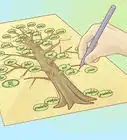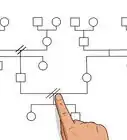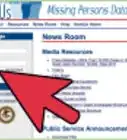This article was co-authored by wikiHow Staff. Our trained team of editors and researchers validate articles for accuracy and comprehensiveness. wikiHow's Content Management Team carefully monitors the work from our editorial staff to ensure that each article is backed by trusted research and meets our high quality standards.
There are 7 references cited in this article, which can be found at the bottom of the page.
This article has been viewed 55,681 times.
Learn more...
A pedigree, also known as a genogram or a family tree, is a chart that traces family lineage or how a specific genetic trait has been transmitted over generations. To read a pedigree you need to understand its symbols, layout, and where to find detailed information. With a little bit of understanding you should be able to read any pedigree and get the lineage or genetic information that you need.
Steps
Understanding the General Layout
-
1Figure out the orientation of the pedigree. Pedigrees can be laid out in a variety of orientations. Assess whether the chart is oriented either vertically or horizontally on the page. Look at the orientation of the words to understand which direction it should be held.
-
2Trace lines in the pedigree. The lines on a pedigree can indicate biological or personal relationships. On a pedigree that is oriented vertically, a horizontal line connecting two individuals indicates a reproductive relationship, such as a marriage. A line that connects individuals vertically indicates the biological relationship of parent and child.[1]
- On a pedigree that is oriented horizontally the vertical lines indicate a reproductive relationship and the horizontal lines indicate the relationship of parent and child.
- Two short lines crossing a horizontal line typically indicate the end of a committed relationship.
Advertisement -
3Pay attention to rows of subjects to identify specific generations. A pedigree is typically organized so that each generation of people or animals is positioned in a separate row. For example, your subject and all of their siblings will be located on the same row. The subject's parents and all of their siblings will be on the same row. These generational rows will continue on as far back as the pedigree goes.[2]
- These generational rows are not shown with actual row lines per se. They are just shown through the position of these subjects on the page next to each other.
- On some genetic pedigrees there may also be roman numerals off to the side that indicate the specific generations.[3]
-
4Look for standard symbols. There are a few symbols on a genetic pedigree that are generally used. In particular, there are standard symbols used to distinguish between male and female subjects. If a person or animal is female, they will be represented with a circle. If a person or animal is a male, they will be represented with a square.[4]
- Whether a square or circle is filled in gives you key information. A filled in circle or square indicates that the presence of a trait. An empty circle or square indicates the absence of a trait. In some cases there will be circles or squares half filled in. This indicates that the person or animal is a carrier of the trait but does not present with it.
-
5Look for a key of additional symbols. Pedigrees can use a variety of symbols, depending on what trait they are tracing and what they are being used for. If you do not understand a specific symbol, there should be a key included that explains its meaning.
- Keys can have explanations of specific symbols, types of lines, and other information that is important for understanding everything on the pedigree.
- Keys are usually located in a corner of the pedigree.
Tracing Lineage
-
1Find a specific person or animal's name and information. If you are using a pedigree to trace lineage, you should start with a specific person or animal and trace backwards. That pedigree also has additional information you can use, such as the person or animal's date of birth.
- Most animal husbandry pedigree charts are made for dogs and horses that are pure bred. This means that the animal's ancestors were all the same breed or variety of animal.
-
2Identify their parents. In order to identify the parents of your main subject on a family tree that is oriented vertically, trace the vertical line moving up off that person. It should go up a short ways and then connect to a bracket that attaches to a female and male. This female and male are the subject's parents. They should be connected to each other with a horizontal line that signifies that they had a reproductive relationship.
- On a pedigree that is oriented horizontally you will look for a horizontal line that is connected to a bracket that is coming off of your subject. This bracket will connect to the subject's parents.
-
3Look for their siblings. After you have identified the main person or animal you are looking at, you can see who their siblings are by looking at other subjects who are also connected to the parents. Go backwards from the parents and see what other subjects they are connected to in the same way as they are connected to your original subject. These are the original subject's siblings.
-
4Trace the lines further to identify additional ancestors. Look for vertical lines coming off the parents that are connected to brackets that connect to a male and female. This male and female are the grandparents of your original subject. Above these grandparents will be their parents, your subject's great grandparents. You can continue to look back generations for as far as the pedigree allows you to.
- Explore other ancestral connections. For every generation you trace back there are a variety of relatives in addition to grandparents. For example, look at the subject's grandparents. Their siblings should be next to them on the pedigree. These people are the grand uncles and grand aunts of your original subject.[5]
-
5Determine if there has been inbreeding or diseases passed down. One of the main reasons to read an animal's pedigree is to figure out if it is likely to be healthy in the future. Any inheritable traits that are undesirable in the type of animal you are assessing should show up in its pedigree. For example, if you are considering purchasing a pure bred dog, you want to research the common diseases that type of dog might inherit and make sure there is no history of that disease in its pedigree.
- You can also establish that there has been no inbreeding pretty easily by looking at an animal's pedigree. Look at the familial relationships and ensure that the previous generations of the animal were not bred to close relatives.
-
6Find additional information. Pedigrees often list a variety of information about each person or animal in the chart. For people, pedigrees often include birth, death, and marriage dates.[6]
- Dogs that are pure bred often come with a pedigree chart. These charts typically contain additional information about the dog, including their birth and death dates, their registration numbers, and any titles they have earned. They may also include DNA and health information.[7]
Tracing a Genetic Trait
-
1Read the key on the pedigree and identify the oldest generation. If you are looking at a pedigree that traces a specific trait, there should be some information included about what trait it is tracing. To trace the trait, start at the oldest generation. This will allow you to see how it has been passed down through the generations. Look for a roman numeral on the side of the pedigree that shows which generation is number 1.
- If there are no roman numerals included on the pedigree you can still easily determine the first generation. Look for the subjects that only have a line indicating a reproductive relationship connected to them. This indicates that the subjects below them are their children and their parents are not represented on the pedigree.
- The pedigree should also give you information about all of the symbols on the pedigree that are not standard.
-
2Determine whether the trait has shown up in every generation. By looking at the symbols on the pedigree you can see who has been affected by the trait and who has not. Look for filled in circles and squares to see who has been affected. In some cases, just by looking at who has been affected by a trait you can trace it through every generation. If every generation has an occurrence of a trait then that trait is called dominant.[8]
- A dominant trait is one that is will always be expressed if it is present in someone's DNA.
-
3Analyze the pedigree for recessive carriers. As a genetic trait is passed down, there can be people or animals who carry the trait in their DNA but are not affected by the trait. To determine if someone is likely a carrier of a trait, you need to look at the generation before them and the generation after them. If the generation before this person was affected by the trait and a person after them is affected and has no other relatives that have a history of this trait in their family, then that person is a carrier.[9]
- Determining who a carrier is can be difficult when a person has several ancestral lines that could be the source of a trait.
-
4Determine whether the trait is sex linked. By tracing the relationships in a pedigree and seeing who had a trait and who did not, you can get insight into whether the trait is carried on the sex chromosomes, called the x and the y. Look closely at parent and child relationships and see which parents and children had a trait and which did not.[10]
- For example, if males of every generation have the same genetic trait, then that trait is likely carried on the y chromosome, which females do not have.
- If a trait impacts both males and females, it is not linked to sex and is carried on a different type of chromosome. This type of trait is called an autosomal trait.
References
- ↑ https://www.tesd.net/cms/lib/PA01001259/Centricity/Domain/294/pedigree%20act%20key.pdf
- ↑ https://www.tesd.net/cms/lib/PA01001259/Centricity/Domain/294/pedigree%20act%20key.pdf
- ↑ https://www.youtube.com/watch?v=0jg9GmkuPEA
- ↑ https://www.tesd.net/cms/lib/PA01001259/Centricity/Domain/294/pedigree%20act%20key.pdf
- ↑ https://www.youtube.com/watch?v=PM79Epw_cp8
- ↑ https://www.dar.org/sites/default/files/RGG-1003.pdf
- ↑ http://www.danemist.com/ABCs/pedigree.html
- ↑ http://learn.genetics.utah.edu/content/basics/patterns/
- ↑ http://learn.genetics.utah.edu/content/basics/patterns/
About This Article
To read a pedigree, follow the lines on the chart to see who is directly related and how. If there's a horizontal line connecting two individuals, that means they were in a reproductive relationship, like a marriage. Alternatively, if there's a vertical line connecting two individuals, it means they're related biologically as a parent and child. Generally, everyone that's in the same row on the chart is part of the same generation. You can also tell someone's sex by the shape around their name. If it's a square, they're male, and if it's a circle, they're female. To learn how to read and interpret the different symbols used on pedigree charts, keep reading!
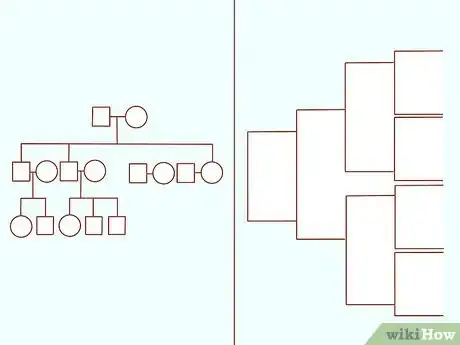
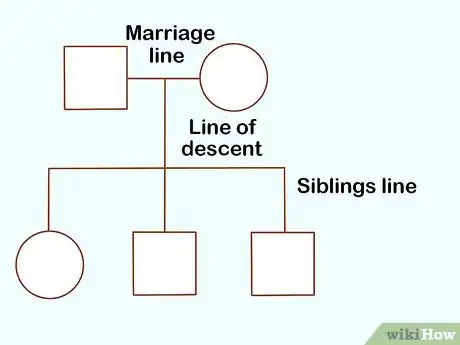
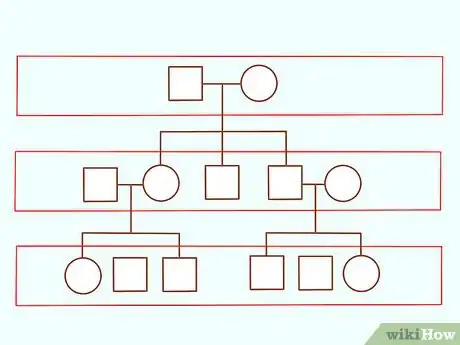
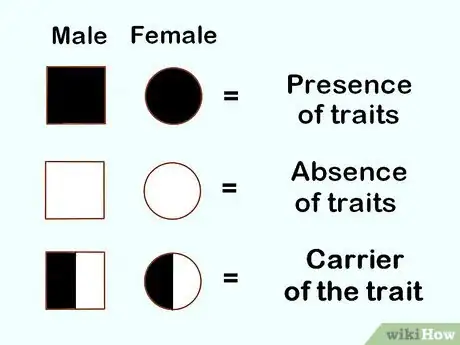

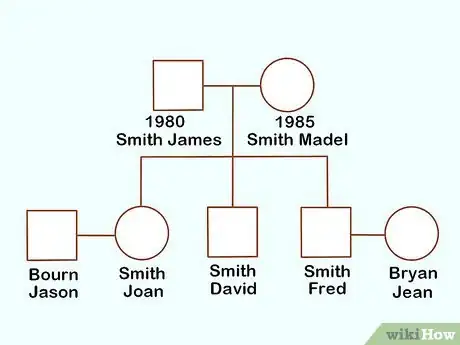
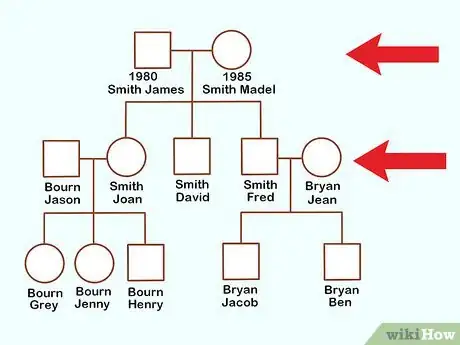

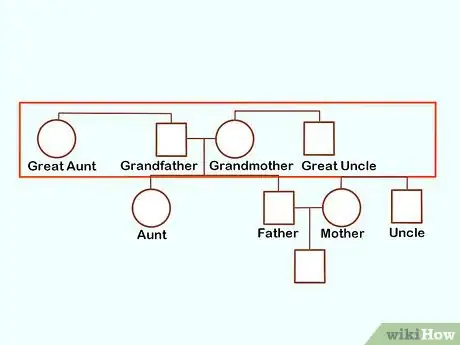

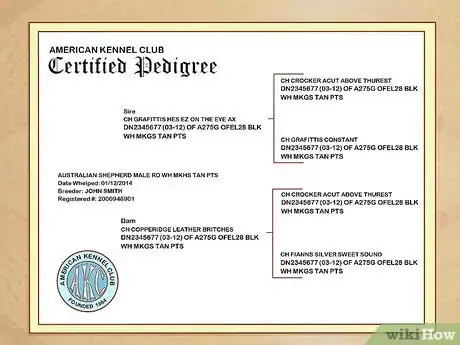
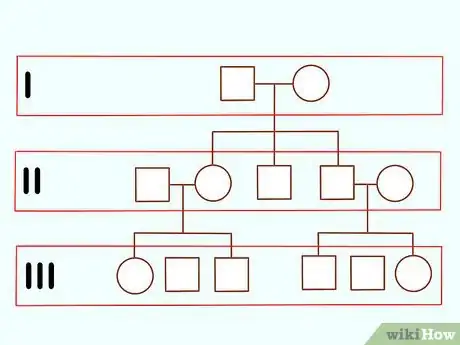
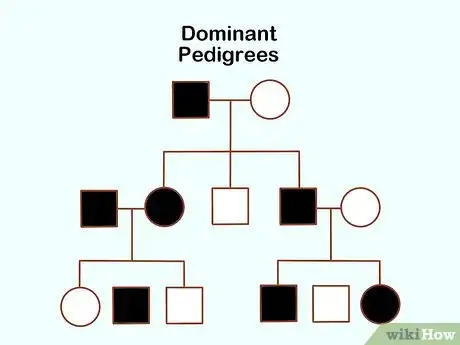
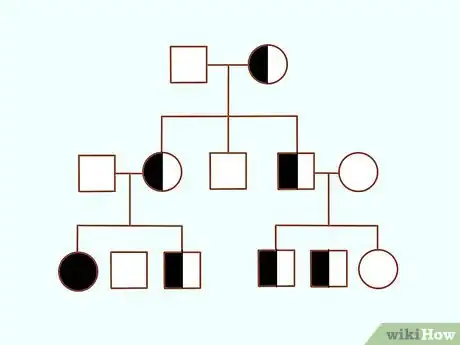
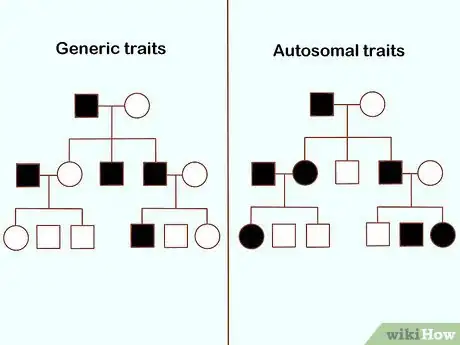
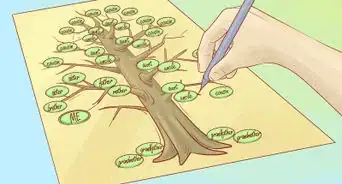
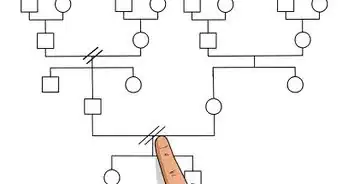




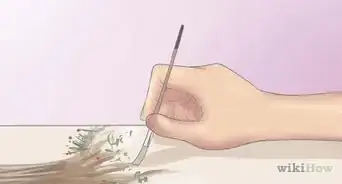


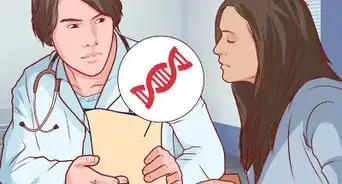



-Step-4-Version-2.webp)







